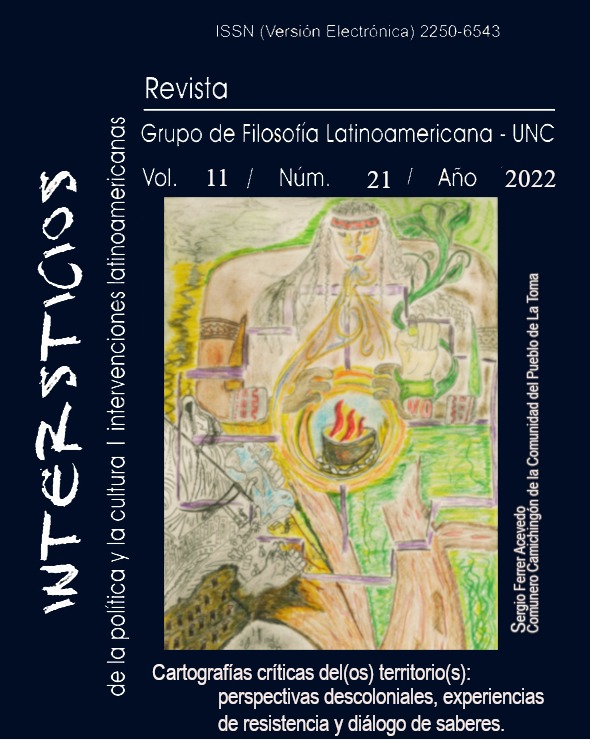Intercultural ties of mestizo and rarámuri women in the Sierra Tarahumara, Mexico
Keywords:
indigenous women, interculturality., re-patriarchalization, bodies, TerritoriesAbstract
For centuries, structures of oppression of various kinds have been combined in the territory of the Sierra Tarahumara. Faced with the geographical and biocultural wealth, injustices and violence haunt the Tarahumara territory and the bodies of the women of the different cultures that have inhabit it for long-standing. There are multiple factors that, historically, have intertwined, resulting in a worrying violation of the collective rights of the original peoples and of the women who inhabit the territory. In the current stage of capitalist accumulation, indigenous communities are plagued by insecurity and drug-trafficking violence, as well as by the stalking of tourism, mining, and extractivist large companies. Despite this, Rarámuri and mestizo women manage to organize themselves, weave and interweave other ways of resistance against the gloomy fate that seems to impose itself inexorably. In this context, the Ane'ma Network, Intercultural Fabric, emerges as a propitious space to feel, think, say and make the territories-land and bodies-territories. In this article, we are interested in problematize the context of the emergence of the Network, based on theoretical readings in dialogue with field notes, and investigate the forms of organization and participation that these women have begun to weave collectively and interculturally.
Downloads
References
Berlanga Gayón, M. (2015). Feminicidio: el valor del cuerpo de las mujeres en el contexto latinoamericano actual. Pelícano, (1), 6-18. Recuperado de https://bit.ly/3PvfSs8
Construcción de Mundos Alternativos Ronco Robles (COMUNARR) A.C. (2021). Herramienta PESTLE para el contexto de la Red Ane´ma Tejido Intercultural. Creel, Chihuahua, México: Autor.
Cruz Hernández, D. (2020). Mujeres, cuerpos y territorios: entre la defensa y la desposesión. En D. Cruz Hernández y M. Bayón Jiménez (Coords.). Cuerpos, territorios y feminismos. Compilación latinoamericana de teorías, metodologías y prácticas políticas (pp.45-61). Ecuador: CLACSO.
Espinoza Damián, G. (2010). Mujeres indígenas y territorios. En C. Rodríguez Wallenius; L., Concheiro Bórquezy M. Tarrio García (Coords.). Disputas territoriales. Actores sociales, instituciones y apropiación del mundo rural (pp. 25-48). México: UAM Unidad Xochimilco.
Falquet, J. (28 de mayo de 2015). De los asesinatos de Ciudad Juárez al fenómeno de los feminicidios: ¿nuevas formas de violencia contra las mujeres? Feminicidio.net Recuperado de https://bit.ly/3lqGA7r
Federici, S. (2018). El patriarcado del salario. Críticas feministas al marxismo. España: Traficantes de sueños.
Gago, V. (2019). La potencia feminista o el deseo de cambiarlo todo. CABA: Tinta Limón.
García Gualda, S. (2020). Muertes silenciadas. Notas para pensar los feminicidios indígenas en Argentina. PACHA. Revista de Estudios Contemporáneos del Sur Global, 1 (1), pp. 45-55. Recuperado de https://bit.ly/3NwlNem
García Gualda, S. (2021). Tejedoras de futuro. Mujeres mapuce y participación política. Neuquén: TOPOS. Editorial del IPEHCS.
García Gualda, S. (2022). La Patagonia injusta: mujeres mapuce y justicia de género. En S. García Gualda, L. Duimich y F. Lizárraga (Coords.). Patagonia: tragedia y sacrificio (pp. 167-186). Buenos Aires: TeseoPress.
García Tórres, M.; Vázquez, E.; Cruz Hernández, D. y Bayón, M. (2020). Extractivismo y (re)patriarcalización de los territorios. . En D. Cruz Hernández y M. Bayón Jiménez (Coords.). Cuerpos, territorios y feminismos. Compilación latinoamericana de teorías, metodologías y prácticas políticas (pp. 23-44). Ecuador: CLACSO.
Gardea García, J. y Chávez Ramírez, M. (Comps.). (2015). Nuestros Saberes Antiguos, Kite amachíala kiya nurúami. México: Servicios Integrales Émuri (SINÉ).
González, V. (24 de abril del 2022). Autoridades comunitarias no reconocen violencia contra mujeres indígenas. El Heraldo de Chihuahua. Recuperado de https://bit.ly/3yJ4aEo
Guzmán, V. (2002). Las relaciones de género en el mundo global. Santiago de Chile: CEPAL.
Harvey, D. (2005). El “nuevo” imperialismo. Acumulación por desposesión. Buenos Aires: Clacso.
Marchese, G. (2019). Del cuerpo en el territorio al cuerpo-territorio: elementos para una genealogía feminista latinoamericana de la crítica a la violencia. EntreDiversidades. Revista de Ciencias Sociales y Humanidades, 6 (2(13), pp. 9-41. https://doi.org/10.31644/ED.V6.N2.2019.A01
Mayorga, P. (15 de octubre del 2020). Desnutrición y COVID-19, mezcla letal para la Sierra Tarahumara. Proceso. Recuperado de https://bit.ly/3wzkoNL
Mies, M. (2019). Patriarcado y acumulación a escala mundial. Madrid: Traficantes de sueños.
Red Ane´ma (2021). Actas internas [no publicadas]. Creel, Chihuahua, México.
Roux, Rhina (2008). Marx y la cuestión del despojo. Claves teóricas para iluminar un cambio de época. Herramienta, (38). Recuperado de https://bit.ly/3zqMElP
Sciortino, S. (2021). La lucha de mujeres es un camino. Buenos Aires: Prohistoria ediciones.
Segato, R. (2002). Identidades políticas / Alteridades históricas una crítica a las certezas del pluralismo global. RUNA. Archivo Para Las Ciencias Del Hombre, 23(1), 239-275. https://doi.org/10.34096/runa.v23i1.1304
Villalobos Díaz, D.; Martínez Esparza, P.; Carrillo Domínguez, H. (2018). Diagnóstico y propuestas sobre la violencia en la Sierra Tarahumara para la sociedad civil, comunidades, autoridades estatales y federales 2006-2017. Consultoría Técnica Comunitaria (CONTEC) A.C. Chihuahua, México: Editorial Aldea Global.
Downloads
Published
Issue
Section
License

This work is licensed under a Creative Commons Attribution-NonCommercial-ShareAlike 4.0 International License.
Authors who have publications with this journal agree to the following terms:
a. Authors will retain their copyright and grant the journal the right of first publication of their work, which will simultaneously be subject to the Creative Commons Attribution License that allows third parties to share the work as long as its author and first publication in this journal are indicated.
b. Authors may adopt other non-exclusive license agreements for distribution of the published version of the work (e.g., deposit it in an institutional telematic archive or publish it in a monographic volume) as long as the initial publication in this journal is indicated.
c. Authors are allowed and encouraged to disseminate their work through the Internet (e.g., in institutional telematic archives or on their web page) after the publication process, which may produce interesting exchanges and increase citations of the published work (see The effect of open access).


